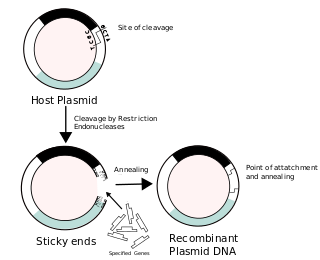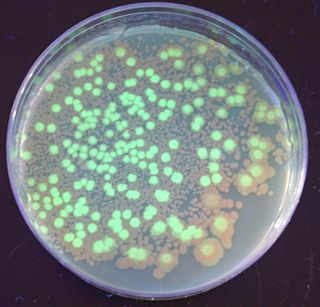Major classes

Extracted from living systems
Some of the oldest forms of biologics are extracted from the bodies of animals, and other humans especially. Important biologics include:[ citation needed ]
- Whole blood and other blood components
- Organ transplantation and tissue transplants
- Stem-cell therapy
- Antibodies for passive immunity (e.g., to treat a virus infection)
- Human reproductive cells
- Human breast milk
- Fecal microbiota
Some biologics that were previously extracted from animals, such as insulin, are now more commonly produced by recombinant DNA.
Produced by recombinant DNA
Biologics can refer to a wide range of biological products in medicine. However, in most cases, the term is used more restrictively for a class of therapeutics (either approved or in development) that are produced using biological processes involving recombinant DNA technology. These medications are usually one of three types:
- Substances that are (nearly) identical to the body's key signaling proteins. Examples are the blood-production stimulating protein erythropoetin, or the growth-stimulating hormone named "growth hormone" or biosynthetic human insulin and its analogues.
- Monoclonal antibodies. These are similar to the antibodies that the human immune system uses to fight off bacteria and viruses, but they are "custom-designed" (using hybridoma technology or other methods) and can therefore be made specifically to counteract or block any given substance in the body, or to target any specific cell type; examples of such monoclonal antibodies for use in various diseases are given in the table below.
- Receptor constructs (fusion proteins), usually based on a naturally occurring receptor linked to the immunoglobulin frame. In this case, the receptor provides the construct with detailed specificity, whereas the immunoglobulin structure imparts stability and other useful features in terms of pharmacology. Some examples are listed in the table below.
Biologics as a class of medications in this narrower sense have had a profound impact on many medical fields, primarily rheumatology and oncology, but also cardiology, dermatology, gastroenterology, neurology, and others. In most of these disciplines, biologics have added major therapeutic options for treating many diseases, including some for which no effective therapies were available, and others where previously existing therapies were inadequate. However, the advent of biologic therapeutics has also raised complex regulatory issues (see below), and significant pharmacoeconomic concerns because the cost for biologic therapies has been dramatically higher than for conventional (pharmacological) medications. This factor has been particularly relevant since many biological medications are used to treat chronic diseases, such as rheumatoid arthritis or inflammatory bowel disease, or for the treatment of otherwise untreatable cancer during the remainder of life. The cost of treatment with a typical monoclonal antibody therapy for relatively common indications is generally in the range of €7,000–14,000 per patient per year.
Older patients who receive biologic therapy for diseases such as rheumatoid arthritis, psoriatic arthritis, or ankylosing spondylitis are at increased risk for life-threatening infection, adverse cardiovascular events, and malignancy. [15]
The first such substance approved for therapeutic use was biosynthetic "human" insulin made via recombinant DNA. Sometimes referred to as rHI, under the trade name Humulin, was developed by Genentech, but licensed to Eli Lilly and Company, who manufactured and marketed it starting in 1982.
Major kinds of biopharmaceuticals include:
- Blood factors (Factor VIII and Factor IX)
- Thrombolytic agents (tissue plasminogen activator)
- Hormones (insulin, glucagon, growth hormone, gonadotrophins)
- Haematopoietic growth factors (Erythropoietin, colony-stimulating factors)
- Interferons (Interferons-α, -β, -γ)
- Interleukin-based products (Interleukin-2)
- Vaccines (Hepatitis B surface antigen)
- Monoclonal antibodies (Various)
- Additional products (tumour necrosis factor, therapeutic enzymes)
Research and development investment in new medicines by the biopharmaceutical industry stood at $65.2 billion in 2008. [16] A few examples of biologics made with recombinant DNA technology include:
| USAN/INN | Trade name | Indication | Technology | Mechanism of action |
|---|---|---|---|---|
| abatacept | Orencia | rheumatoid arthritis | immunoglobin CTLA-4 fusion protein | T-cell deactivation |
| adalimumab | Humira | rheumatoid arthritis, ankylosing spondylitis, psoriatic arthritis, psoriasis, ulcerative colitis, Crohn's disease | monoclonal antibody | TNF antagonist |
| alefacept | Amevive | chronic plaque psoriasis | immunoglobin G1 fusion protein | incompletely characterized |
| erythropoietin | Epogen | anemia arising from cancer chemotherapy, chronic renal failure, etc. | recombinant protein | stimulation of red blood cell production |
| etanercept | Enbrel | rheumatoid arthritis, ankylosing spondylitis, psoriatic arthritis, psoriasis | recombinant human TNF-receptor fusion protein | TNF antagonist |
| infliximab | Remicade | rheumatoid arthritis, ankylosing spondylitis, psoriatic arthritis, psoriasis, ulcerative colitis, Crohn's disease | monoclonal antibody | TNF antagonist |
| trastuzumab | Herceptin | breast cancer | humanized monoclonal antibody | HER2/neu (erbB2) antagonist |
| ustekinumab | Stelara | psoriatic arthritis, psoriasis, ulcerative colitis, Crohn's disease | humanized monoclonal antibody | IL-12 and IL-23 antagonist |
| denileukin diftitox | Ontak | cutaneous T-cell lymphoma (CTCL) | Diphtheria toxin engineered protein combining Interleukin-2 and Diphtheria toxin | Interleukin-2 receptor binder |
| golimumab | Simponi | rheumatoid arthritis, psoriatic arthritis, ankylosing spondylitis, ulcerative colitis | monoclonal antibody | TNF antagonist |
| vedolizumab | Entyvio | ulcerative colitis, Crohn's disease | monoclonal antibody | α4β7 integrin blocker |
| ixekizumab | Taltz | plaque psoriasis, psoriatic arthritis, ankylosing spondylitis, non-radiographic axial spondyloarthritis | humanized monoclonal antibody | IL-17A neutralizer |
Vaccines
Many vaccines are grown in tissue cultures.
Gene therapy
Viral gene therapy involves artificially manipulating a virus to include a desirable piece of genetic material.
Viral gene therapies using engineered plant viruses have been proposed to enhance crop performance and promote sustainable production. [13]








